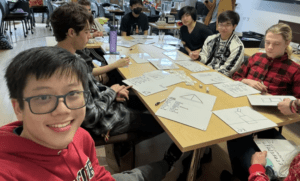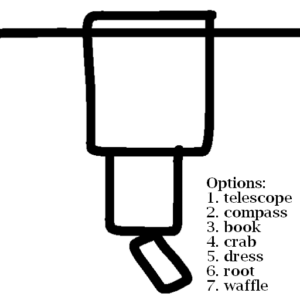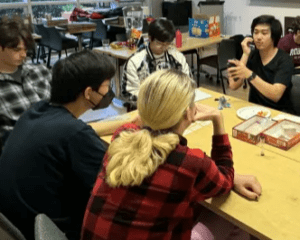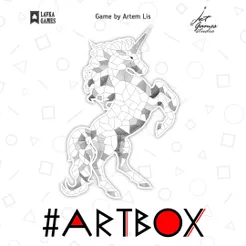With a group of nine friends in the Burbank Lecture Theater, I played Artbox: a judging game where everybody has to draw a picture… with heavy limitations. Developed by Artem Lis, a Russian board game designer, Artbox is a 3-8 player game with an 8+ age rating—though the game is so accessible that it’s been rated lower (6+) on boardgamegeek.com! This game is only accessible through a physical, in-person copy; it requires several tools to set up, so it is not the most accessible game for those who want to play something on a whim.
As a brief summary of the game (no analysis here yet), everybody draws a card with the name of an object (e.g., “toilet”), and one person rolls three dice with shapes on their faces (e.g., “line” or “circle” or “square”). These dice dictate which shapes MUST be used to create the drawing (no fewer, no more!), and everyone gets to draw. The object cards are then all shuffled together and displayed to everybody, who must guess which object correlates with which drawing. Players earn points based on two categories: (a) the most correct correlations and (b) the most guessed drawings within the guessing time limit. The gameplay then repeats for as many rounds as needed!

Despite having never heard of this game before playing it, this game turned out to be really fun! What do I mean by “fun”? From the list of aesthetics posed in the Northwestern MDA analysis paper, I felt this game personally evoked feelings of challenge, fellowship, and expression. Artbox was challenging when trying to tie other drawings of a series of shapes to an object, social through our reactions and commentary as we received our topic ideas and reviewed other drawings, and expressive through the many interpretations and alignments of shapes into our representations of an object. (For example, I’ve re-drawn a picture you can vaguely see in the screenshot above, below. Can you guess what it is out of the provided options?)

The answer to the above picture was number 6. Although this was a relatively more straightforward guess, figuring out how to align shapes (in this case, a line and three rectangles) to make this easy to guess required a lot of thinking outside the box. We often felt the real challenge of dealing with limitations when conveying and guessing objects when our assigned shapes were especially ruthless. In one round, we had one player draw a clock, and another player draw a compass… which felt like a 50/50 chance. In another round, one player had drawn a snake, and the other had drawn a mustache. In these tough differentiations, I had to get inside the artist’s head to think about their intentions: “If it were a snake, would they have made it only have two curves? Or maybe they just didn’t have enough leeway?”
I want to clarify that Artbox is also a timed drawing game. Everybody is always doing something at some given point in time, which makes it harder to disengage and leave the magic circle. However, it doesn’t become exhausting due to the low difficulty curve (you’re literally drawing shapes) and time for breaks (most socializing happened after drawings were revealed). This is also the phase in which judging primarily happens.

What type of judging is this? How does it make people feel? I argue that the judging phase of Artbox contributes to a friendlier and funnier group dynamic. In my experience, this wasn’t the type of judging that makes players feel criticized or bad about their art skills; instead, because everyone is judging under the same limitations under a short time frame, it became a game where I found myself trying to empathize with the artist, put myself into their shoes, and figure out why the heck their drawing looks the way it does. (Perhaps it’s an inside joke? A satirical take? Maybe I’m looking at it the wrong way?) By being a challenging game, nobody ends up butthurt about their art quality (mostly because everybody’s art quality ends up pretty bad…). Moreover, because everybody draws and gains points independently, there are no incentives for a level of deception, creating a positive environment.
Regarding the judging itself, everyone engages actively with each other’s work—which isn’t done in complete silence! There were lively debates, a lot of shared laughter, and a lot of confused reactions as people tried to piece things together. Although everybody judges (guesses) individually, generating revelations led to collective responses: when there was only one drawing in our game that looked remotely close to a “camera,” there’d be a reaction like “woooow… I wonder what that one is” (with a lot of sarcasm). Additionally, a lot of learning happens during the judging phase. Having players give active feedback (“hmmm… that one looks like… a bridge? what’s that line in the middle?” — a player’s comment on my parachute) helped me adjust my strategies and improve in future rounds.

In conclusion, Artbox was a great example of how games can mix simplicity with challenge, creating positive social dynamics. Rather than focusing on artistic prowess, the game emphasizes interpretation and understanding, prompting players to better themself through feedback and collaboration and creating an engaging, lighthearted environment. Moreover, the judging phase of Artbox stands out as a component that deepens the group dynamics by switching focus from individual ability to group discussion. In a cheesy sense, Artbox is not just a game of drawing within lines, but a journey of seeing beyond them—into the eyes of your critics. 🙂


